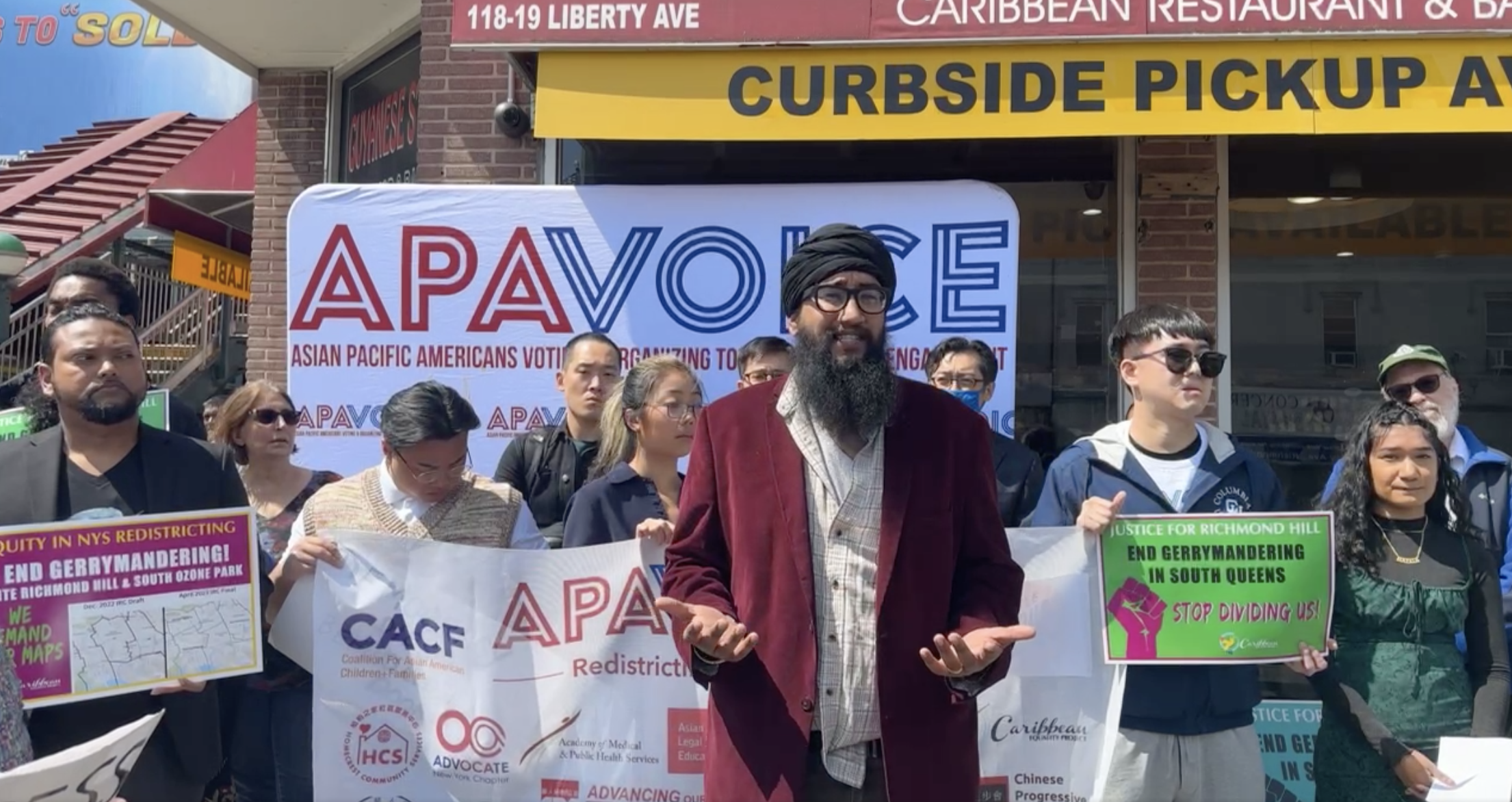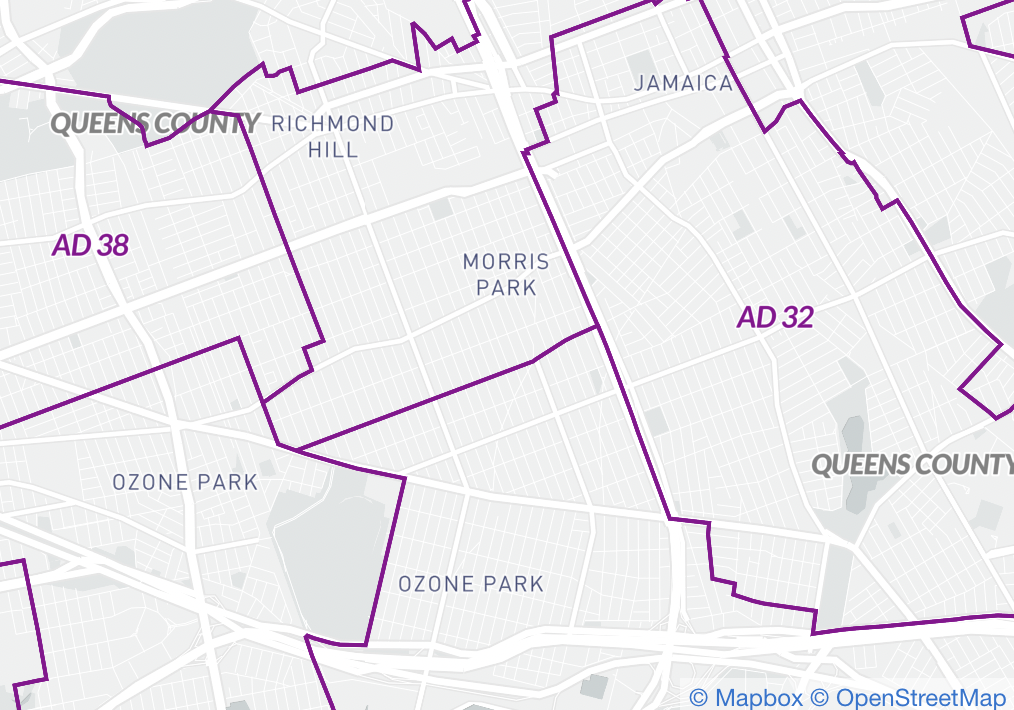As Assembly lines are approved, Queens locals rally against them in Richmond Hill
/Activists gathered in Richmond Hill on Monday morning to protest the now-approved Assembly district lines, which they say unfairly split up Richmond Hill and Ozone Park’s South Asian and Indo-Caribbean communities. Photo from Desis Rising Up and Moving/Twitter
By Ryan Schwach
Both chambers of the New York State legislature voted overwhelmingly on Monday to approve Assembly district lines after a nearly two year process. However, that did not stop some advocates from Queens from protesting the maps as late as Monday morning.
In February, more than a dozen Queens residents gave testimony that did something rare – applaud work done by the New York State Redistricting Commission. Two months later, many of those same advocates rallied again, but this time, they called out the NYIRC for undoing the very work they applauded two months ago.
Advocates from the South Asian and Indo-Caribbean communities centered in Richmond Hill and South Ozone Park rallied on Lefferts Boulevard on Monday to protest the newly approved lines, which they say maintains unfair districts that splits up and dilutes their growing political voice.
The NYIRC’s last draft of maps released in December, for the first time ever, contained the bulk of those communities into a single 24th Assembly District, which was applauded by community groups at public hearings, most of whom belong to the APA Voice Redistricting Task Force, who advocate more generally for Asian representation in New York City.
“[These groups] dominated those hearings when it came to the South Asian community being kept together, I challenge you to find any opposition as loud and as unified as our APA Voice Redistricting Task Force,” Liz OuYang, the coordinator of the group, said at the Monday morning rally.
“They said come testify at these hearings, tell us what you think about these Dec. 1 maps,” she added. “It was disingenuous. They went back on it and there was no credible public evidence to support it otherwise. So it leaves you with the conclusion that something happened behind closed doors and democracy dies behind closed doors.”
In the most recent maps, released last week and approved by the State Assembly by a 132-13 vote and a 59-1 Senate vote on Monday, the lines are nearly identical to current maps illegally drawn and passed by lawmakers last year, which kept the community split into a number of districts.
Boroughwide, all but two new Queens districts are more than 95 percent similar to the ones currently in place, according to the CUNY Graduate Center’s Steven Romalewski.
Currently, the South Asian communities of South Central Queens are chifley split into three districts represented in Albany by Assemblymembers Khaleel Anderson, David Weprin and Jenifer Rajkumar. Very small portions of the area are also represented by Assemblymembers Andrew Havesi, Stacey Pheffer-Amato and Vivian Cook.
At the Monday morning rally, advocates voiced their displeasure with the IRC, and called on the legislature to reject the lines, an effort made moot a few hours later.
“Our community has been resilient in our fight for an equitable district,” said Anjali Seegobin, of the South Queens Womens’ March. “We never felt closer to that becoming a reality until the IRC released its proposed map for AD24 in December of last year. Richmond Hill and South Ozone Park residents literally dominated the public testimony at the most recent IRC hearing.”
The new district lines for the area around Richmond Hill and Ozone Park. Screenshot from NYS Redistricting & You
Seegobin said that the group has been marginalized and ignored by their lack of ethnic representation in political office.
“We refuse to be part of multiple districts again, and our voices are diluted and overlooked,” she said.
The advocates argued that the maps had been drawn in a way that protects incumbency and that the long community input process the IRC engaged in has been made null and void.
“The hierarchy is not independent if you're putting politics over the advocacy of community groups,” said Felicia Singh, an activist and one time City Council candidate.
Rajkumar, the first South Asian woman elected to state office in the history of the legislature, represents the northwestern corner of Richmond Hill and voted for the lines on Monday.
Though she celebrated the fact that her district will remain mostly identical to its current formation, she added that she believed “common-sense district lines that give South Asian New Yorkers the political voice they deserve” are still needed.
“I am very pleased to report that my district remains intact and its people united,” Rajkumar said in a statement to the Eagle. “Upon my re-election I vow to be a representative of not only my district, but all emerging ethnic communities within Queens.”
“Despite the victory for unity in District 38, the South Asian community of Richmond Hill, South Richmond Hill, Ozone Park, and South Ozone Park did not fare as well,” Rajkumar added. “These neighborhoods are now split among four Assembly districts. We must keep fighting until these South Asian communities are unified in one district.”
Assemblymember David Weprin represents the majority of Richmond Hill and a large portion of the South Asian population in that area. Weprin voted to approve the maps on Monday.
“I weighed in early on about trying to keep them together,” said Weprin. “But the end result from this is basically status quo, and the lines now the way they are, it's the same lines that I have now.”
Weprin believes the new maps are significantly better than previous drafts, which saw the Richmond Hill area even more split.
“These were a tremendous improvement for keeping the South Asian and Indo-Caribbean community together as opposed to the previous lines before that,” he said. “I'm not unhappy, but at the same time, I thought it was an important consideration to keep the communities together.”
Weprin, himself of Jewish descent, has represented AD24 since 2010, and was preceded by his brother, Mark Weprin.
Weprin says he “can’t complain” about the lines because they mostly mirror his preexisting district, one he knows how to operate in.
“I will serve that community well, and will continue at least until the end of my term and hopefully after reelection,” he said.
Anderson declined to comment.
The City Council lines for those communities are the subject of an ongoing lawsuit from community members who claim that the lines, which split the area into multiple districts, violate the city charter. That case is still awaiting a decision from a judge.





